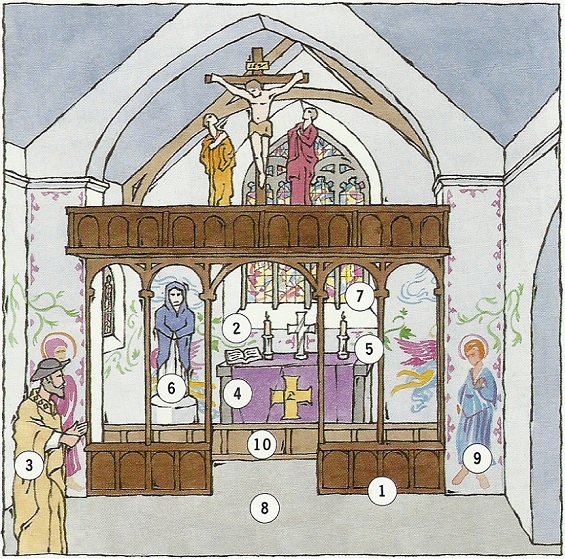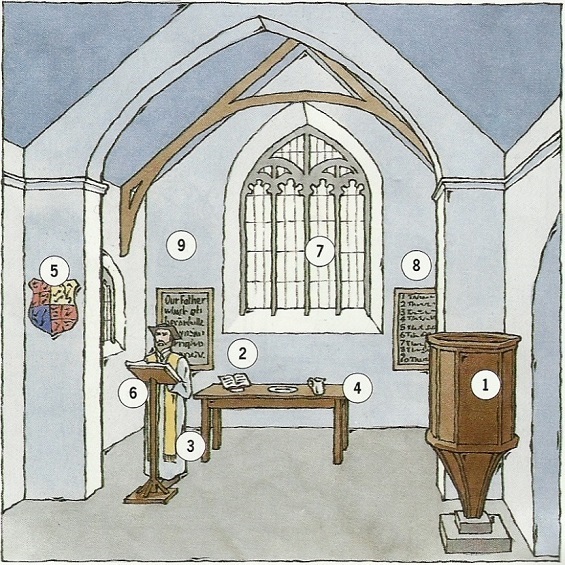
Catholics and Protestants

Introduction
The two pictures below show what an English church might have looked like, first in 1533 (left), then in 1570 (right).
After you have studied this webpage, answer the question sheet by clicking on the 'Time to Work' icon at the top of the page.
Links:
The following websites will help you research further:
Martin Luther:
• Luther's life
• Luther and the Reformation - video
![]()
![]()
1 A Typical English Church in 1533 |
A Typical English Church in 1570 |
 |
 |
1. Rood screen. 2. Service book in Latin. 3. Priest. 4. Stone altar, on the east wall of the church. 5. Candles. 6. Statue of the Virgin Mary. 7. Stained-glass windows. 8. Nave. 9. Colourful paintings on the walls. 10 Altar rail.
|
1. Pulpit for preaching. 2. Book of Common Prayer in English. 3. Minister. 4. Plain Communion table, pulled away from the east wall of the church. 5. Royal coat of arms. 6. Bible in English. 7. Plain glass windows. 8. Wall tablets on which the Ten Commandments and the Lord's Prayer are written. 9 . Plain, whitewashed walls. |
Introduction – continued
In the years between 1533 and 1570, England rejected the Roman Catholic religion and adopted a new kind of Christianity. This new religion had started in Germany. Its leader was a monk called Martin Luther.
In Rome, the popes were building huge churches and decorating them with beautiful works of art. To raise enough money, they sold indulgences (a 'guarantee' of your place in heaven). In 1517, Luther protested about this, and about many other things that he said were wrong with the Church. For this reason, he and his supporters were called 'Protestants'.
Many areas of Germany threw out the Roman Catholic Church. They wanted to reform the Church; this is why this period is sometimes called 'the Reformation'.
The table in Source 2 shows how Protestantism was different from Catholicism:
2 How Protestantism was different from Catholicism in the 16th Century
| Roman Catholics | Protestants |
|
The Pope is Head of the Church. |
The local ruler should control the Church. |
|
The local Church should be ruled by bishops. |
The Church should be run by elders, elected by the people. |
|
The priest brings Christ to the people, in the service of the Mass. |
A minister must preach to the people, to tell them what the Bible says. |
|
At the service of the Mass, the bread and wine turn into the body and blood of Jesus (transubstantiation). |
The Communion service is just a service to remember Jesus' death. The bread wine stay as bread and wine. |
|
There should be statues of the saints and the Virgin Mary in church. Saints and the Virgin Mary can take a person's prayers to God. |
Statues of the saints and the Virgin Mary are as bad as idols. Only Jesus can take a person's prayers to God. |
|
Services and the Bible should be in Latin. |
Services and the Bible should be in English, so people can understand them. |
|
A person is saved by going to church and doing good works. |
A person is saved by one thing only – a personal faith in Jesus Christ. |
|
Priests should wear bright robes, and churches should have colourful paintings and beautiful music, to show how great God is. |
Ministers' clothes and churches should be plain, so people can concentrate on God. There should not be any music in the services. |
|
Priests must not marry. |
Ministers can marry. |